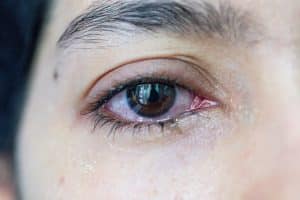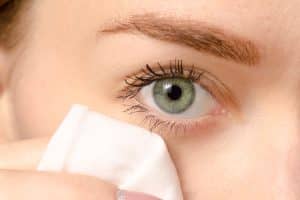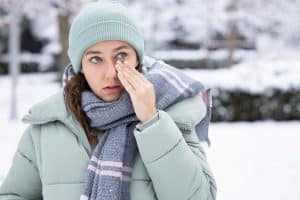When shopping for eye drops for dry eyes or other irritating eye conditions, you may have noticed that there are two categories of drops: those that contain preservatives and those that don’t. Getting the right type of eye drops can make the difference between solving your problem and living with your condition for that much longer – so what is the difference between preservative and preservative-free eye drops?
Are eye drops with preservatives bad?
At first glance, the difference between these two types of eye drops may seem obvious, but it’s the effects of the inclusion or exclusion of preservatives that will make a difference to you. Simply put, preservatives affect how long you can use the eye drops for after opening the container.
Eye drops that contain preservatives will stay safe to use for longer than their preservative-free counterparts. This can be useful if you often find your eye drops expire before you’ve used them all up – meaning they’re a good choice for those who don’t need to use eye drops very frequently.[1]
On the other hand, preservative-free eye drops will expire quicker. It’s important not to use eye drops after the expiry date printed on the container, as once this date has passed, the drops might not help with your condition any more. Eye drops that have expired may even irritate your eyes further or cause an infection – so it’s best to err on the side of caution.[2] However, many preservative-free eye drops give you plenty of time to use them even if you don’t use them every day. For example, our range of eye drops can be used for up to three months after being opened.
Are preservatives bad for your health?
If eye drops that contain preservatives last longer, why should you bother using preservative-free eye drops such as TheraTears® Dry or Tired 50+ Eye Drops For Older Eyes? Well, the answer is that preservative-free eye drops can be better suited to people who use eye drops frequently. For example, if you regularly use eye drops multiple times a day to resolve common problems like dry eyes or eye strain, preservative-free eye drops may be the better choice for you.
This is because preservatives can be irritating to the eyes when applied frequently. If you only use eye drops once or twice a week, the preservatives will be washed away and won’t build up enough to cause irritation. However, using eye drops more often will increase the total amount of preservatives, which can cause irritation such as itchy, reddened eyes.[1]
Some people also have a hypersensitivity to preservatives, meaning they experience this irritation regardless of how frequently they use eye drops that contain preservatives. For this reason, it’s a good idea to first test a new brand or type of eye drops while you’re at home. That way, if you do find them irritating, you can wash them out immediately to help alleviate the itchiness.[1]
If you find eye drops with preservatives irritating, then preservative-free eye drops may be a suitable alternative. You may also find relief from irritation with eye drops described as containing gentle preservatives. These do contain preservatives, but these preservatives break down as soon as they make contact with your eye in order to avoid irritation. You might consider these eye drops to be the best of both worlds.
Here at TheraTears®, our eye experts recommend that if you use eye drops once a day or more, you should stick to preservative-free or gently preserved products such as TheraTears® Overnight Eye Drops, which contain cross-linked hyaluronic acid to refresh and rejuvenate tired eyes while you sleep. It’s especially important to avoid irritated eyes at night, as this can prevent you from getting a good night’s rest.
How to tell if eye drops are preservative-free
To find out if the eye drops you’re thinking of getting are preservative-free, check the product information. This can usually be found on the website selling the product, and it should also be printed on the product packaging and container. If you’re at all unsure, a pharmacist may be able to help you identify any preservatives listed in the product ingredients. Remember, preservative-free eye drops contain no preservatives at all, whereas gently preserved products contain a preservative that breaks down when it makes contact with the surface of the eye. For example, the gently preserved products offered by TheraTears – such as TheraTears® Screen Eyes Eye Drops – break down into a mixture of water, oxygen and electrolytes when you apply them.
At TheraTears, all of our hydrating 5-in-1 eye drops are either preservative-free or gently preserved, meaning you won’t have to worry about irritation when you’re treating dry eyes or eye strain.
Resources:
[1] Walsh, Karen, and Lyndon Jones. “The use of preservatives in dry eye drops.” Clinical ophthalmology (Auckland, N.Z.) vol. 13 1409-1425. 1 Aug. 2019, doi:10.2147/OPTH.S211611 Available at: https://www.ncbi.nlm.nih.gov/pmc/articles/PMC6682755/
[2] https://www.nhs.uk/common-health-questions/medicines/why-do-medicines-have-expiry-dates/







